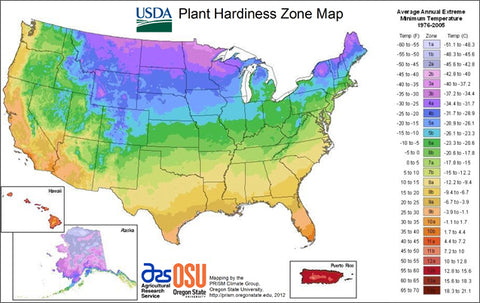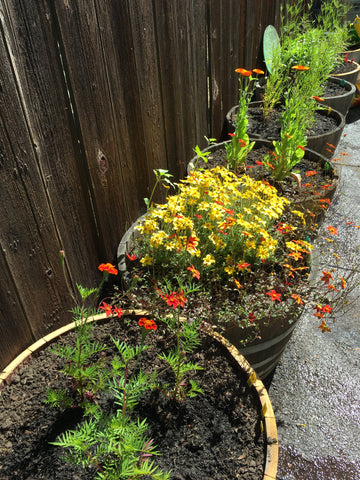News / Sincere Sheep
January - Dye-It-Yourself: Garden Planning

Happy New Year! We are so excited about what we have planned for you in 2020 here at Sincere Sheep. In addition to all of the usual goodness, including newsletters, Made Here Club shipments, classes, and shows, this month, we’re beginning a new year-long blog series: Dye-It-Yourself.
As you might imagine, we have so much DIY fun planned! We’ll be guiding you through this dyeing journey from the very beginning. We’ll assist you in planning a dye garden, selecting the seeds to grow, growing your plants (and suggesting fun food-based natural dye and stain projects to tide you over while you wait for your plants to grow), harvesting your dyestuffs, the actual dyeing itself, and finally, seed saving. We can all share photos of our progress, process, successes, and more on Instagram with the hashtag #sinceresheepdiy
This month, we’re starting to plan our garden, and we hope you’ll join us and start planning your own. We’ll suggest ways for you to start planning, as well as helpful resources if you’re excited to start reading more about natural dyes right now.
Find Your Growing Zone
Sincere Sheep is located in beautiful Napa, California. In our area, this is the time of year that’s cooler and wetter than in the summer months. Even though we don’t get terribly severe cold winter weather, we still observe growing seasons. This is the time of year when we think about our garden for the coming year. If you’re in the Northern Hemisphere, chances are the same is true for you.

The 2012 USDA Plant Hardiness Zone Map is the standard by which gardeners and growers can determine which plants are most likely to thrive at a given location. The map is based on the average annual minimum winter temperature, divided into 10-degree F zones. You can type in your zip code to determine what zone you are in. A good place to start planning any garden is to figure out your zone and maybe even begin to familiarize yourself with what kinds of plants grow best in your area.
Determine Your Garden Space
Some people have lots of space for planting, and others have room for only a few pots on a windowsill. Take a look at the space around you. What kind of sun do certain areas get? Where would plants thrive? As a rule of thumb most dye plants need at least half the day in sun and two-thirds generally is better. Begin to think about what could work for you.
Dreams and Reality
As you start to plan your garden, by all means, dream big. Think of all the things you might want to grow, how beautiful they will look, and all the amazing things you will dye. Maybe you’ve been wanting to do a garden for years, and this is the perfect opportunity! Or maybe it’s a great reason to finally get moving on those raised beds you’ve been contemplating. Make lists if you want! Maybe even draw color-coded diagrams of your dream garden, if that helps you find a vision that you love.
But keep in mind that growing and maintaining a garden of any kind, including a dye garden, takes resources, including time and space. It doesn’t have to be an expensive project, but chances are you will have to buy some seeds and buy or borrow some gardening tools if you don’t already have them. This reality check is not intended to dampen your enthusiasm. It’s merely a suggestion that If you’re new to keeping a garden, maybe limit yourself to 2-3 types of dye plants, and see how it goes this year. You’ll be weeding, watering, and engaging in related garden care over the growing season. You don’t want to spread yourself too thin or get to July and feel totally overwhelmed by all the plant children in need of attention.
Dye Plant Options
Don’t worry too much at this point about choosing which particular dye plants you will grow. Get a sense of what’s possible for you in your space. We’ll get into seed sourcing next month, but shades of yellow are the most widely available. We’ll be talking mostly about the following six plants in the coming year:
- Dyer’s coreopsis (bronzy-yellow)
- Dyer’s chamomile (yellow)
- Marigolds (gold)
- Sulphur Cosmos (orange/yellow)
- Weld (clear yellow)
- Indigo (blue)
Working Together
I know, I know. Some of you are thinking, “How could I possibly limit myself to 2-3 types of plants? I want more colors!” If this is you, consider cooperating with other people who are also excited about this project. If you can find a partner either in your region or outside of your region, you have the opportunity to widen your options for dyestuffs. For example, maybe your time, space, and location will allow you to grow Marigolds and Dyer’s Coreopsis. But you’re so excited to try indigo, and you have this terrible sinking feeling that you’ll be missing out. One way to assuage your FOMO is to find (or make!) a friend who’ll grow plants different from yours and will trade with you after harvest time. Start asking around to see who might want to do this project with you!
Resources For Learning About Natural Dyeing
As you begin to dream about your garden, you may find yourself wondering about more of the specifics around natural dyeing. Here are some suggestions for books and online resources that we respect, find accessible to the beginning natural dyer, and will help you create more lasting natural color on fiber. Some of these books are out of print but you can still find them. Also, remember that your library is a great resource for these books.
Books
A Dyer’s Garden, by Rita Buchanan (1995)
A Weaver’s Garden, by Rita Buchanan (1987)
Harvesting Color, by Rebecca Burgess (2011)
The Modern Natural Dyer, by Kristine Vejar (2015)
The Art and Science of Natural Dyes: Principles, Experiments, and Results, by Joy Boutrup & Catherine Ellis (2019)
A Garden to Dye For, by Chris McLaughlin (2014)
10 Plants for Color by Deepa Preeti Natarajan & Helen Krayenhoff
Online
https://www.fs.fed.us/wildflowers/ethnobotany/dyes.shtml
Turkey Red Journal: https://www.turkeyredjournal.com/
Graham Keegan: http://www.grahamkeegan.com/indigo-vat-basics
Ecotone Threads / Kori Hargreaves: http://www.ecotonethreads.com/
Catherine Ellis: https://blog.ellistextiles.com/
Fall is in the Air! | Time to work on cozy knits
The Napa Valley is a frenzy with harvest. Truck loads of gondolas are trundling up and down the valley delivering grapes to local wineries. It's a sure sign cooler weather - and the premiere crafting season - is on the way. It's also an exciting time for me because I have a Fall full of shows - which means I'll get to see you - after taking a hiatus over the summer months.
Lambtown This Weekend
Lambtown is a family friendly event held in Dixon, CA every year. For the second year this event will be open both Saturday & Sunday. Sincere Sheep is in booth #1 just like last year. I look forward to seeing you there.
Other Upcoming Shows
Another great event this Fall is Interweave Knitting Lab, October 31 - November 3, which is being held again in San Mateo, CA at the Marriott Hotel. There are still spaces available in classes (find more class information and registration here).
For the second year {Among Friends} yarn & pattern club kicks off the knitting season with two new clubs. We had a great time over the summer with Knitting Love Sewing, a yarn and project bag club. You can see the yarn and what people made in the {Among Friends} Ravelry group.
I hope this newsletter finds you well and crafting to your heart's content!
Sincerely,
Brooke



